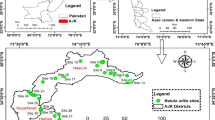Abstract
Floristic surveys were carried out in different land use systems(primary and secondary forest, fallows of different ages, cocoa plantations,crop fields) within the forest zone of Cameroon, to assess the impact of landconversion on above-ground plant biodiversity. Beside various diversity studies,plant density was measured and diameter at breast height was estimated.The results showed that the forest areas, which represent thehistoric biodiversity of the region, preserve the greatest number of species(160 species in primary forest and 171 in secondary forest). Our resultsindicate the relatively great importance of secondary forests as refuge areasfor primary forest plant species that may function as a starting point forpossible regeneration of original biodiversity. Species richness is reducedprogressively from the original forest (160 spp.) and secondary forests (171spp.), to Chromolaena odorata (Asteraceae) fallow fields(149 spp.), to an old fallow field (139 spp.), to a cocoa plantation (116 spp.)and to the farmland (64 spp.), where only weeds and crops contribute essentiallyto plant biodiversity. Also the number of species that are used for non-timberproducts (construction, food and medicines) decreased with increased landconversion.
Similar content being viewed by others
References
Aldhous P. 1993. Tropical deforestation: not just a problem in Amazonia. Science 259: 1390.
Balick M.J., Nee M.H. and Atha D.E. 2000. Checklist of the vascular plants of Belize. Memoirs of the New York Botanical Garden 85: 1–246.
Brown I.F., Filho E.V.S., Paula F.C. and Ovalle A.R.C. 1989. Measurement of deposition at tree canopy level in a subtropical premontane wet forest, Rio de Janeiro, Brazil. Biotropica 21: 15–19.
Brown S., Hall C.A.S., Knabe W., Raich J., Trexler M.C. and Woomer P. 1993. Tropical forests: their past, present and potential future in the terrestrial carbon budget.Water, Air and Soil Pollution 70: 71–94.
Brower J.E. and Zar J.H. 1977. Field and Laboratory Methods for General Ecology. Brown Publishers, Dubuque, Iowa.
Daget J. 1976. Les Methodes Mathematiques en Ecologie. Collection d'Ecologie. Masson, Paris.
Dajoz R. 1982. Precis d'Ecologie. 4e edn. Bordas, Paris.
Devineau J.L. 1984. Structure et Dynamique de Quelques Forets Tropophiles de l'Ouest Africain (Cote d'Ivoire). Programme MAB Savane. Universite d'Abidjan, Abidjan, Ivory Coast.
Duguma B. 1993. Description of land use systems in the humid lowlands of Cameroon. In: Kiki A. and Tiki—Manga T. (eds), Biophysical and socio-economical characterisation of the humid forest zone of Cameroon. Proceedings of the National Symposium of the Cameroon ASB Project, 6–8 December 1993, Kribi, Cameroon.
Frontier S. and Pichod-Viale D. 1993. Ecosystemes: structure, fonctionnement, evolution. Collection ´ d'ecologie 21. Masson, Paris.
Fujisaka S., Bell W., Thomas N., Hurtado L. and Crawford E. 1995. Slash-and-burn agriculture conservation to pasture and deforestation in two Brazilian colonies. Agriculture, Ecosystems and Environment 59(1–4): 115–130.
Kotto-Same J., Wooner P.L., Moukam A. and Zapfack L. 1997. Carbon dynamics in slash-and-burn agriculture and land use alternatives of the humid forest zone in Cameroon. Agriculture, Ecosystems and Environment 65: 245–256.
Letouzey 1985. Notice de la carte phytogeographique du Cameroon au 1:500 000. Institut de la carte international de la vegetation, Toulouse, France.
Malaisse F. 1984. Contribution a l'etude de l'ecosysteme foret dense seche (Muhulu). Structure d'une foret dense s'che zambezienne des environs de Lubumbashi (Za?re). Bulletin de la Societe Royale de Botanique de Belgique 117: 428–458.
Pielou E.C. 1966. Species diversity and patten diversity in study of ecological succession. Journal of theoretical Biology 10: 370–383.
Raunkiaer C. 1934. The Life Forms of Plants and Statistical Plant Geography. Clarendon Press, Oxford, UK.
Sokpon N. 1995. Recherches ecologiques sur la foret dense semi-decidue de Pobe au Sud du Benin: groupements vegetaux, regeneration naturelle et chute de litiere, Ph.D. Thesis, Universite libre de Bruxelles, Brussels, Belgium.
Sonke B. 1998. Etudes floristiques et structurales des forets de la reserve de faune du Dja (Cameroun), Ph.D. Thesis, Universite libre de Bruxelles, Brussels, Belgium.
Sonke B. and Lejoly J. 1998. Biodiversity study in Dja fauna reserve (Cameroon): using the transect method. In: Huxley C.R., Lock J.M. and Cutler D.F. (eds), Chorology, Taxonomy and Ecology of the Floras of Africa and Madagascar. Royal Botanic Gardens, Kew, UK, pp. 171–179.
Thenkabail P.S. 1999. Characterization of the alternative to slash-and-burn benckmark research area representing the Congolese rainforests of Africa using Near-Real-Time SPOT HRV data. International Journal of Remote Sensing 20: 839–877.
Turner I.M., Tan H.T.W., Wee Y.C., Ibrahim A.B., Chew P.T. and Corlett R.T. 1994. A study of plant species extinction in Singapore: lessons for the conservation of tropical biodiversity. Conservation Biology 8: 705–712.
Webb L.J., Tracey J.G. and Williams W.T. 1976. The value of structural features in tropical forest typology. Australian Journal of Ecology 1: 3–28.
White J.T.L. 1992. Vegetation history and logging disturbance: effects on rain forest mammals in the Lope reserve, Gabon (with special emphasis on elephants and apes), Ph.D. Thesis, University of Edinburgh, Edinburgh, UK.
Zapfack L., Nkongmeneck B.A., Villiers J.F. and Lowman M. 1996. The importance of Pteridophytes in the epiphytic flora of some phorophytes in the Cameroonian semideciduous rain forest. Selbyana 17: 76–81.
Author information
Authors and Affiliations
Rights and permissions
About this article
Cite this article
Zapfack, L., Engwald, S., Sonke, B. et al. The impact of land conversion on plant biodiversity in the forest zone of Cameroon. Biodiversity and Conservation 11, 2047–2061 (2002). https://doi.org/10.1023/A:1020861925294
Issue Date:
DOI: https://doi.org/10.1023/A:1020861925294




